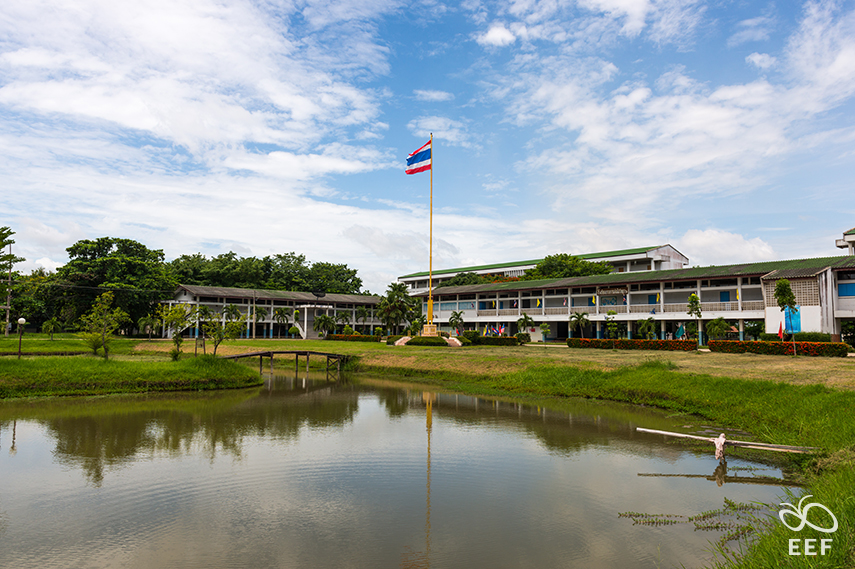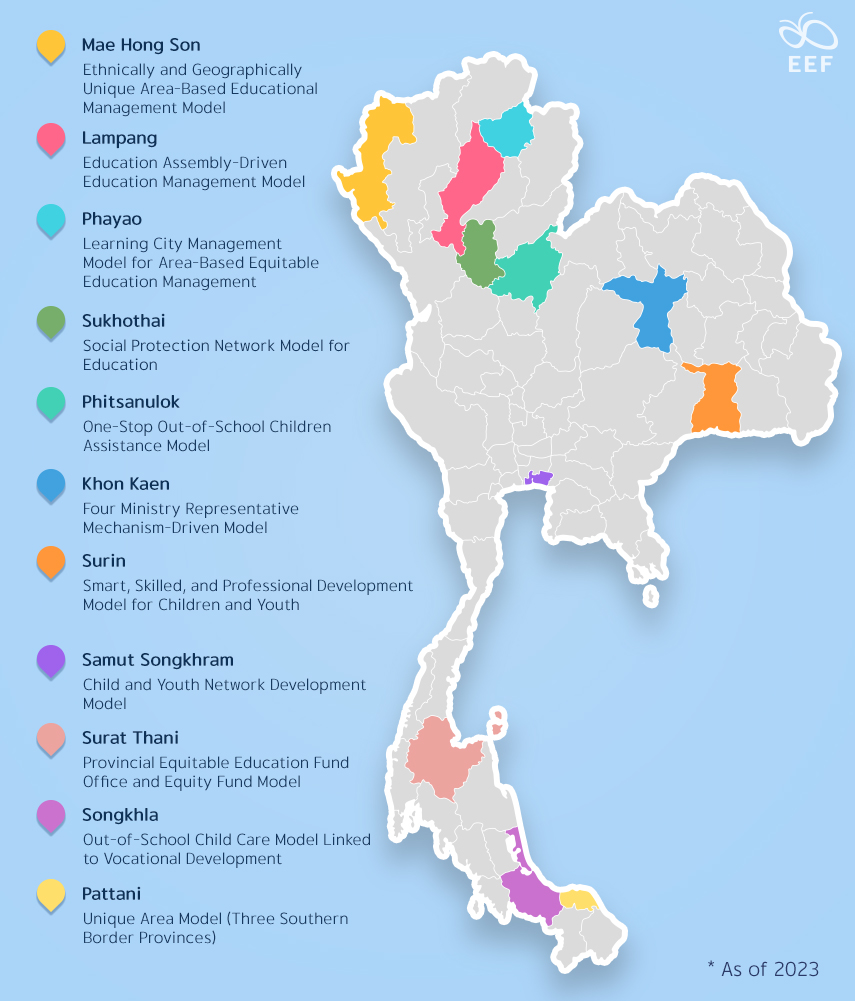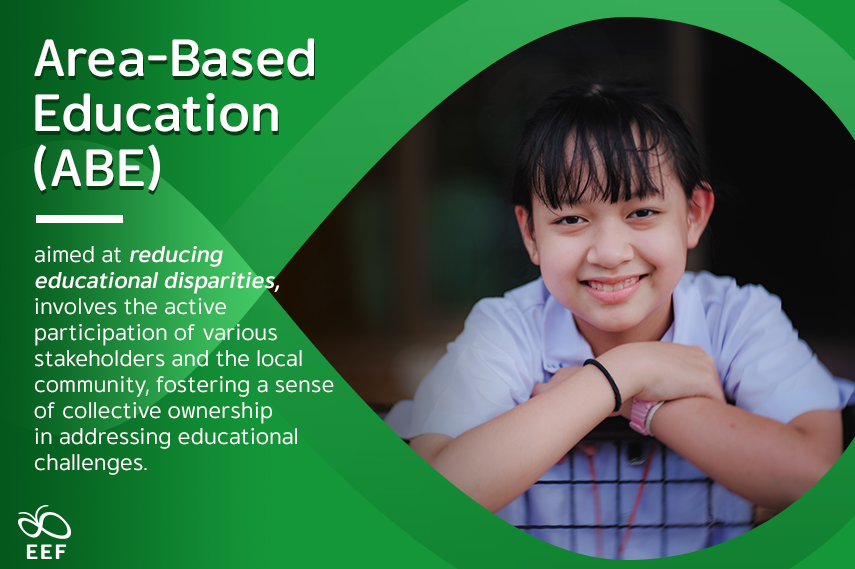
A significant number of children and youth in Thailand are currently on the verge of leaving the educational system for various reasons and necessities, posing a pressing challenge to the country. While the Equitable Education Fund (EEF) Thailand’s efforts can assist merely a fraction, adopting a distributed approach to tackle educational disparities at smaller scales, and engaging communities at the local level, holds promise for more widespread assistance, given the diverse characteristics of areas. This approach, known as “Area-Based Education (ABE)” focusing on creating a model to dismantle educational disparities into manageable local units, underscores collaborative mechanisms in data, knowledge, and educational resource management. The ultimate aim is to propel policy expansion, creating a cohesive front in data and knowledge management for a comprehensive resolution of educational challenges.

ABE enables the prompt addressing of weaknesses and the optimal leveraging of strengths in response to current circumstances. The success of each province’s initiatives hinges on identifying a starting point or “dot” aligned with their objectives, fostering collaboration among various sectors. This initial “dot” encompasses diverse challenges and resources, prompting a critical overarching question as to how to tailor the decentralization of educational authority for varied contexts. To operate effectively on a local level, interconnecting the “dots” is imperative, amplifying the success of each dot and fostering significant advancements until their contribution to the overall effort is evident. However, achieving this requires a comprehensive understanding of the system, paired with a sense of collective ownership in addressing educational challenges from the local level up.
Decentralizing the educational management system to the local level is crucial for addressing persistent educational inequalities sustainably, with ABE playing a pivotal role in this decentralization process. Representing a paradigm shift from conventional approaches, ABE moves away from centralized policies towards decentralized models that champion inclusivity and diversity, cultivating innovative education practices for lifelong learning and personal development. At the core of this transformative project is the emphasis on crafting localized educational management mechanisms within provinces, powered by provincial-level database systems.

Leveraging the existing database system network, ABE grants each province the autonomy to tailor management methods to their distinct challenges. The mechanism is three-pronged, involving external support agencies such as the EEF, public agencies such as Provincial Education Committees (PEC), and civil society agencies including individuals interested in addressing educational disparities. These entities collectively provide adaptable funding, operational methods, knowledge, and processes for transformative initiatives. Notably, it is these individuals who form a core team collaborating with various sectors at the local level, distributing resources from external and public agencies to address local issues. The overarching goal is to ensure holistic care and targeted assistance for children and youth based on their individual needs, ushering in a systematic and progressive educational approach.

In 2022, Thailand initiated a groundbreaking network of ABE mechanisms, rallying collaborative support from the EEF across 12 provinces: Mae Hong Son, Sukhothai, Phayao, Lampang, Phitsanulok, Samut Songkhram, Rayong, Khon Kaen, Surin, Surat Thani, Songkhla, and Pattani. This collective endeavor aimed at addressing educational disparities serves as a beacon, illustrating the pivotal role each individual plays in the recovery of children’s lives. Across these provinces, diverse strategies emerged at the provincial or regional levels, emphasizing the decentralization of power through innovative solutions, thereby forming a solid foundation for future expansions of the EEF’s support to other areas.

The diverse strategies enacted across the provinces underscore the nuanced nature of reducing inequality. Engaging in exchanges exposes unique methods for reaching target groups and establishing connections. By narrowing the focus down to local levels, a profound understanding of authentic community problems emerges. And ABE led the charge in forging innovative work systems, pioneering novel pathways in both general and vocational education. Through collaborations with local authorities, intimately acquainted with children and youth, it champions local involvement, identifying resources and pathways to create a supportive environment for them. This, in turn, laid the groundwork for children and youth to realize their full potential, fostering self-reliance in future populations.
The accomplishments of the mechanisms in the ABE project highlight its transformative focus on addressing inequality, shifting from universal equality to narrowing gaps by enhancing access and nurturing abilities. This emphasis involves the deep identification of target groups, where the integration of local data ensures effective connections and promises sustained support. It facilitates prompt, targeted, and personalized assistance beyond temporary relief for vulnerable groups. This, yet again, reiterates that at the forefront of this project is the concept of freedom, encompassing the freedom to determine strategies and approaches responsive to each area’s distinctive context and the freedom to devise solutions tailored to diverse potentials and circumstances. These methods intricately link to resource utilization, enabling a prioritized sequence of resource deployment.

Area-Based Education (ABE), aimed at reducing educational disparities, involves the active participation of various stakeholders and the local community, fostering a sense of collective ownership in addressing educational challenges. The mechanism is crafted in a localized format, poised to serve as a policy model for decentralizing power in the future. The ABE framework is not linear but rather resembles a winding path, involving iterative cycles to instigate systemic changes from the local to national levels. The operationalization of ABE includes data collection at the provincial level, linking and integrating work, developing context-aligned innovations, managing knowledge networks, and proposing ABE prototype models and policy recommendations before looping back for continuous refinement. The outcomes of ABE implementation are two fold: policy changes and local transformations. This multifaceted approach reflects the dynamic and cyclical nature of ABE, ultimately contributing to a future where educational power is decentralized.
ABE aligns seamlessly with the four policy dimensions of the Equitable Education Fund (Thailand), aiming to equalize educational opportunities, tailor education to learners’ life contexts, ensure diverse educational options, and foster collaboration among various agencies in each area. The synergy of these dimensions allows each province or region to collaborate within itself, leading to the discovery of tools and work processes, thereby giving rise to a central mechanism for data reception and internal situation reporting. This empowerment enables each province to independently manage its education, fostering independence — a mission perfectly encapsulated by the EEF, which aims to reduce education inequality through research, collaboration, and support for children, youth, and adults in need.

